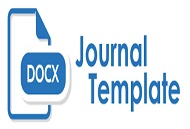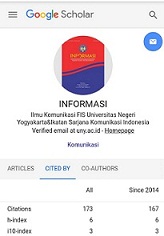Gemoy and Samsul: How The Propaganda Won The 2024 Indonesian Election
DOI:
https://doi.org/10.21831/informasi.v54i2.75464Keywords:
propaganda, 2024 Indonesia General Election, public communication campaignAbstract
This study aims to determine the forms of political buzzer propaganda ahead of the 2024 election on Twitter/X. The research method used is a qualitative approach using content analysis and the type of data used is secondary data in the form of tweets or uploads that themed the 2024 presidential election. The data was inputted manually using Microsoft Excel and then analyzed systematically using the SPSS 25 program. The chi square test result is < .001, which means that there are significant differences between candidates in the forms of propaganda. Tweets discussing Prabowo-Gibran were the most propaganda-laden which included name calling, transfer, testimonial, card stacking, and bandwagon, with the exception of plain folks, which is propaganda that shows the efforts of the presidential and vice presidential candidates' closeness to the public, in this category, candidate pair number three, namely Ganjar-Mahfud, is significantly higher than other candidate pairs, and gliterring generalities, namely propaganda with positive connotations on the presidential and vice presidential candidate pairs being discussed, in this case candidate pair number one Anies Imin is significantly higher than other pairs. Name-calling was the most significantly utilized in tweets discussing Prabowo-Gibran, compared to other form of propaganda in tweets discussing the other two candidate pairs. This highlighted the importance of spinning the unfavorable attributes to become a favorable one.
References
Aspinall, E., Fossati, D., Muhtadi, B., & Warburton, E. (2018, April 24). Mapping the Indonesian political spectrum. New Mandala. https://www.newmandala.org/mapping-indonesian-political-spectrum/
Banurea, O. K. (2023). Efektivitas Pengawasan Kampanye Berbasis Digital: Pencegahan Pelanggaran Praktek Kampanye Berbasis Digital). Mediation : Journal of Law, 59–77. https://doi.org/10.51178/mjol.v2i1.1356
Berelson, B. (1952). Content Analysis in Communication Research. Free Press.
Budiarto, G., Yuliati, D., & Puguh, D. R. (2021). Rising Sun in the Eastern Horizon of Java: The Occupation of Japanese 16th Army in Banyuwangi, East Java 1942-1945. E3S Web of Conferences, 317, 04013. https://doi.org/10.1051/e3sconf/202131704013
Dewantara, J. A., Syamsuri, S., Wandira, A., Afandi, A., Hartati, O., Cahya, N., Sapitri, P., & Nurgiansah, T. H. (2022). The Role of Buzzers in Social Media in Guiding Public Opinion Regarding Political Choices. JED (Jurnal Etika Demokrasi), 7(3), Article 3. https://doi.org/10.26618/jed.v7i3.8103
Dharma, F. A., Hariyanto, D., & Muharram, F. (2023). Construction of Political Identity on Instagram: Unveiling the Kadrun Hashtag Movement in Indonesia's 2024 Presidential Election: Academia Open, 8(2), Article 2. https://doi.org/10.21070/acopen.8.2023.6922
Dina Wulandari, C., Muqsith, M., & Ayuningtyas, F. (2023). Fenomena Buzzer Di Media Sosial Jelang Pemilu 2024 Dalam Perspektif Komunikasi Politik. Avant Garde, 11, 134–147.
Firmansyah, M. A., Mulyana, D., Karlinah, S., & Sumartias, S. (2018). Kontestasi Pesan Politik dalam Kampanye Pilpres 2014 di Twitter: Dari Kultwit Hingga Twitwar. Jurnal Ilmu Komunikasi, 16(1), Article 1. https://doi.org/10.31315/jik.v16i1.2681
Hidayat, R. N. (2020). Penggunaan Buzzer Politik di Media Sosial Pada Masa Kampanya Pemilihan Umum. ADALAH, 4(2), Article 2. https://doi.org/10.15408/adalah.v4i2.15606
Mustika, R. (2019). PERGESERAN PERAN BUZZER KE DUNIA POLITIK DI MEDIA SOSIAL. Diakom : Jurnal Media Dan Komunikasi, 2(2), 144–151. https://doi.org/10.17933/diakom.v2i2.60
Nimmo, D. D. (1978). Political Communication and Public Opinion in America. Goodyear Publishing Company.
Putra, S. K., & Damanik, S. F. (2021). Hate Speech About Politics in Social Media. Talenta Conference Series: Local Wisdom, Social, and Arts (LWSA), 4(2), Article 2. https://doi.org/10.32734/lwsa.v4i2.1208
Rice, RE., & Atkin, CK. (2008). PUBLIC COMMUNICATION CAMPAIGNS: Theoretical Principles and Practical Applications. In Media Effects (3rd ed.). Routledge.
Saraswati, M. S. (2020). The political campaign industry and the rise of disinformation in Indonesia. In R. Tapsell & A. Sinpeng (Eds.), From Grassroots Activism to Disinformation: Social Media in Southeast Asia. ISEAS-Yusof Ishak Institute.
Sugiono, S. (2020). Fenomena Industri Buzzer Di Indonesia: Sebuah Kajian Ekonomi Politik Media. Communicatus: Jurnal Ilmu komunikasi, 4(1), 47–66. https://doi.org/10.15575/cjik.v4i1.7250
Sunarwan, W., & Surlia, S. P. (2021). STRATEGI PENCITRAAN POLITIK CAPRES JOKOWI MELALUI INSTAGRAM: SEBUAH ANALISIS KONTEN KUALITATIF. JURNAL EKONOMI, SOSIAL & HUMANIORA, 3(01), Article 01.
Ulfa, K., Purnomo, E. P., & Kasiwi, A. N. (2020). The Campaign Strategy of 2019 Presidential and Vice-Presidential Elections on Social Media. Society, 8(2), Article 2. https://doi.org/10.33019/society.v8i2.137
Umami, A. M., & Qindy, F. H. A. (2023). The Use of Buzzers by Political Parties Which Result in Black Campaign Practices in Indonesia. JISIP (Jurnal Ilmu Sosial Dan Pendidikan), 7(4), Article 4. https://doi.org/10.58258/jisip.v7i4.5853
Yuliati, D. (2012). MEWASPADAI PROPAGANDA MELALUI KAJIAN SEJARAH (STUDI ATAS SISTEM PROPAGANDA JEPANG DI JAWA 1942-1945). HUMANIKA, 15(9). https://doi.org/10.14710/humanika.15.9
Yusuf, R. I. (2023). Komunikasi Politik: Seni dan Teori. Deepublish.
Downloads
Published
How to Cite
Issue
Section
Citation Check
License
Authors who publish with this journal agree to the following terms:
- Authors retain copyright and grant the journal right of first publication with the work simultaneously licensed under a Creative Commons Attribution License that allows others to share the work with an acknowledgement of the work's authorship and initial publication in this journal.
- Authors are able to enter into separate, additional contractual arrangements for the non-exclusive distribution of the journal's published version of the work (e.g., post it to an institutional repository or publish it in a book), with an acknowledgement of its initial publication in this journal.
- Authors are permitted and encouraged to post their work online (e.g., in institutional repositories or on their website) prior to and during the submission process, as it can lead to productive exchanges, as well as earlier and greater citation of published work (See The Effect of Open Access).











